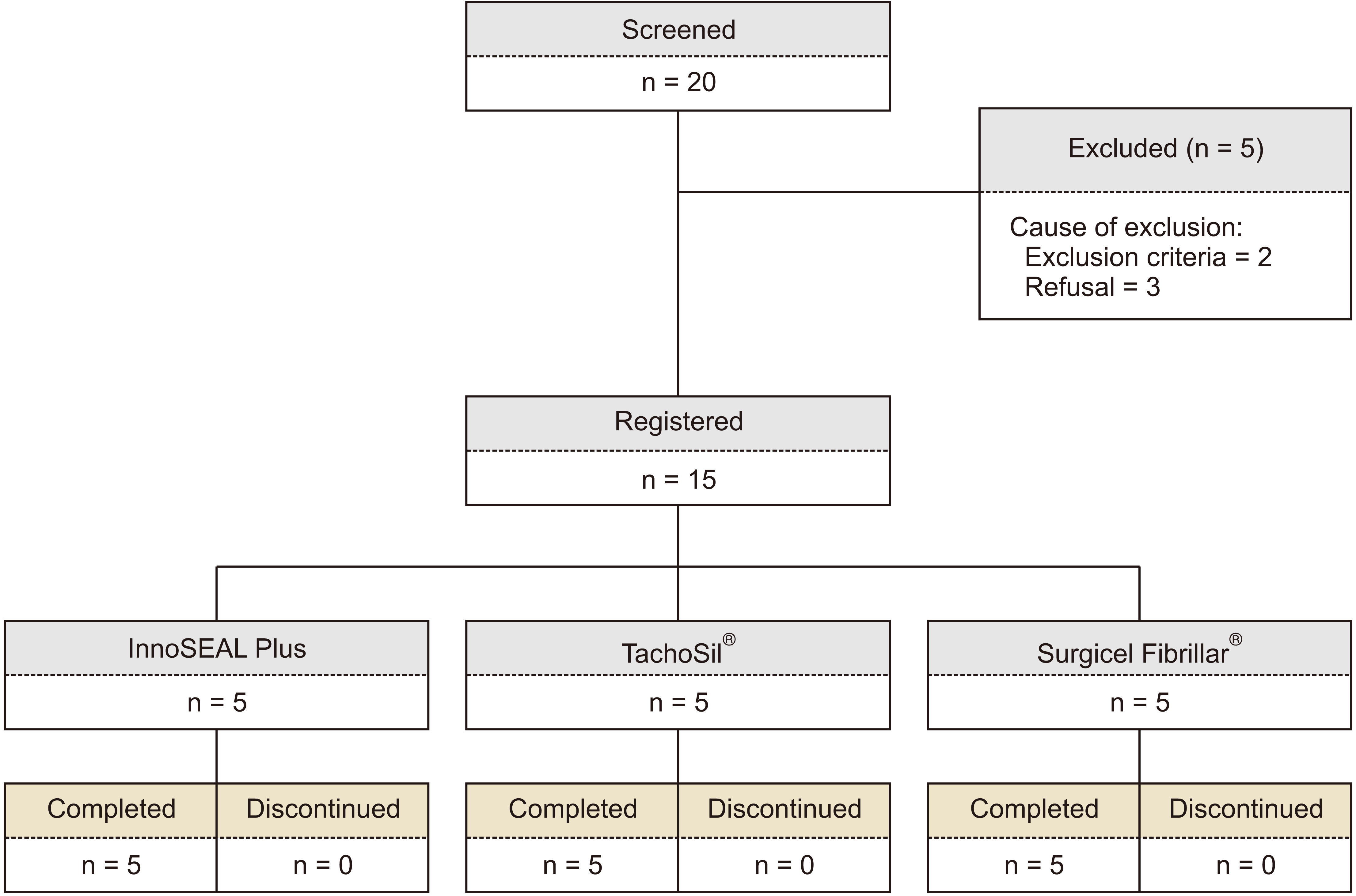2. Nagano Y, Togo S, Tanaka K, Masui H, Endo I, Sekido H, et al. 2003; Risk factors and management of bile leakage after hepatic resection. World J Surg. 27:695–698. DOI:
10.1007/s00268-003-6907-x. PMID:
12732991.

4. Chapman WC, Clavien PA, Fung J, Khanna A, Bonham A. 2000; Effective control of hepatic bleeding with a novel collagen-based composite combined with autologous plasma: results of a randomized controlled trial. Arch Surg. 135:1200–1204. DOI:
10.1001/archsurg.135.10.1200. PMID:
11030881.

5. Jackson MR, MacPhee MJ, Drohan WN, Alving BM. 1996; Fibrin sealant: current and potential clinical applications. Blood Coagul Fibrinolysis. 7:737–746. DOI:
10.1097/00001721-199611000-00001. PMID:
9034553.
6. Hong S, Yang K, Kang B, Lee C, Song IT, Byun E, et al. 2013; Hyaluronic acid catechol: a biopolymer exhibiting a pH-dependent adhesive or cohesive property for human neural stem cell engineering. Adv Funct Mater. 23:1774–1780. DOI:
10.1002/adfm.201202365.

7. Lee BP, Dalsin JL, Messersmith PB. 2002; Synthesis and gelation of DOPA-modified poly(ethylene glycol) hydrogels. Biomacromolecules. 3:1038–1047. DOI:
10.1021/bm025546n. PMID:
12217051.

8. Park JY, Kim JS, Nam YS. 2013; Mussel-inspired modification of dextran for protein-resistant coatings of titanium oxide. Carbohydr Polym. 97:753–757. DOI:
10.1016/j.carbpol.2013.05.064. PMID:
23911511.

9. Lee C, Shin J, Lee JS, Byun E, Ryu JH, Um SH, et al. 2013; Bioinspired, calcium-free alginate hydrogels with tunable physical and mechanical properties and improved biocompatibility. Biomacromolecules. 14:2004–2013. DOI:
10.1021/bm400352d. PMID:
23639096.

10. Hong SH, Shin M, Lee J, Ryu JH, Lee S, Yang JW, et al. 2016; STAPLE: stable alginate gel prepared by linkage exchange from ionic to covalent bonds. Adv Healthc Mater. 5:75–79. DOI:
10.1002/adhm.201400833. PMID:
25761562.

11. You I, Kang SM, Byun Y, Lee H. 2011; Enhancement of blood compatibility of poly(urethane) substrates by mussel-inspired adhesive heparin coating. Bioconjug Chem. 22:1264–1269. DOI:
10.1021/bc2000534. PMID:
21675788.

12. Lee Y, Lee SH, Kim JS, Maruyama A, Chen X, Park TG. 2011; Controlled synthesis of PEI-coated gold nanoparticles using reductive catechol chemistry for siRNA delivery. J Control Release. 155:3–10. DOI:
10.1016/j.jconrel.2010.09.009. PMID:
20869409.

13. Ryu JH, Lee Y, Kong WH, Kim TG, Park TG, Lee H. 2011; Catechol-functionalized chitosan/pluronic hydrogels for tissue adhesives and hemostatic materials. Biomacromolecules. 12:2653–2659. DOI:
10.1021/bm200464x. PMID:
21599012.

14. Kim YM, Kim CH, Park MR, Song SC. 2016; Development of an injectable dopamine-conjugated poly(organophophazene) hydrogel for hemostasis. Bull Korean Chem Soc. 37:372–377. DOI:
10.1002/bkcs.10686.

15. Mehdizadeh M, Weng H, Gyawali D, Tang L, Yang J. 2012; Injectable citrate-based mussel-inspired tissue bioadhesives with high wet strength for sutureless wound closure. Biomaterials. 33:7972–7983. DOI:
10.1016/j.biomaterials.2012.07.055. PMID:
22902057. PMCID:
PMC3432175.

16. Fan C, Fu J, Zhu W, Wang DA. 2016; A mussel-inspired double-crosslinked tissue adhesive intended for internal medical use. Acta Biomater. 33:51–63. DOI:
10.1016/j.actbio.2016.02.003. PMID:
26850148.

17. Kim K, Ryu JH, Koh MY, Yun SP, Kim S, Park JP, et al. 2021; Coagulopathy-independent, bioinspired hemostatic materials: a full research story from preclinical models to a human clinical trial. Sci Adv. 7:eabc9992. DOI:
10.1126/sciadv.abc9992. PMID:
33762330. PMCID:
PMC7990328.

19. Emilia M, Luca S, Francesca B, Luca B, Paolo S, Giuseppe F, et al. 2011; Topical hemostatic agents in surgical practice. Transfus Apher Sci. 45:305–311. DOI:
10.1016/j.transci.2011.10.013. PMID:
22040778.

22. Albes JM, Krettek C, Hausen B, Rohde R, Haverich A, Borst HG. 1993; Biophysical properties of the gelatin-resorcin-formaldehyde/glutaraldehyde adhesive. Ann Thorac Surg. 56:910–915. DOI:
10.1016/0003-4975(93)90354-K. PMID:
8215668.

25. Lewis KM, Spazierer D, Urban MD, Lin L, Redl H, Goppelt A. 2013; Comparison of regenerated and non-regenerated oxidized cellulose hemostatic agents. Eur Surg. 45:213–220. DOI:
10.1007/s10353-013-0222-z. PMID:
23950762. PMCID:
PMC3739866.

26. Schwartz M, Madariaga J, Hirose R, Shaver TR, Sher L, Chari R, et al. 2004; Comparison of a new fibrin sealant with standard topical hemostatic agents. Arch Surg. 139:1148–1154. DOI:
10.1001/archsurg.139.11.1148. PMID:
15545559.

27. Frilling A, Stavrou GA, Mischinger HJ, de Hemptinne B, Rokkjaer M, Klempnauer J, et al. 2005; Effectiveness of a new carrier-bound fibrin sealant versus argon beamer as haemostatic agent during liver resection: a randomised prospective trial. Langenbecks Arch Surg. 390:114–120. DOI:
10.1007/s00423-005-0543-x. PMID:
15723234.





 PDF
PDF Citation
Citation Print
Print




 XML Download
XML Download